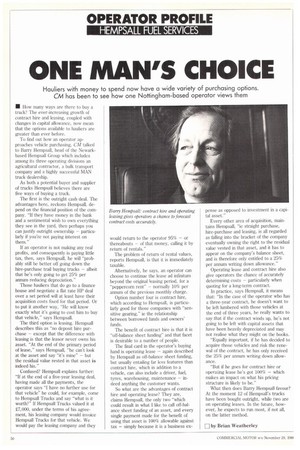ONE MAN'S CHOICE
Page 52

If you've noticed an error in this article please click here to report it so we can fix it.
Hauliers with money to spend now have a wide variety of purchasing options. CM has been to see how one Nottingham-based operator views them
• How many ways are there to buy a truck? The ever-increasing growth of contract hire and leasing, coupled with changes in capital allowance, now mean that the options available to hauliers are greater than ever before.
To find out how an operator approaches vehicle purchasing, CM talked to Barry Hempsall, head of the Newarkbased Hempsall Group which includes among its three operating divisions an agricultural contractor, a bulk transport company and a highly successful MAN truck dealership.
As both a potential buyer and supplier of trucks Hempsall believes there are five ways of buying a truck.
The first is the outright cash deal. The advantages here, reckons Hempsall, depend on the financial position of the company. "If they have money in the bank and a sentimental wish to own everything they see in the yard, then perhaps you can justify outright ownership — particularly if you're not paying interest on them."
If an operator is not making any real profits, and consequently is paying little tax, then, says Hempsall, he will "probably still be better off going down the hire-purchase trail buying trucks — albeit that he's only going to get 25% per annum reducing depreciation."
Those hauliers that do go to a finance house and negotiate a flat rate HP deal over a set period will at least have their acquisition costs fixed for that period. Or to put it another way, "He will know exactly what it's going to cost him to buy that vehicle," says Hempsall.
The third option is leasing. Hempsall describes this as "no deposit hire purchase — except that the difference with leasing is that the leasor never owns his asset. "At the end of the primary period of lease," says Hempsall, "he can't look at the asset and say "it's mine" — but the residual value rested in that asset is indeed his."
Confused? Hempsall explains further: "If at the end of a five-year leasing deal, having made all the payments, the operator says "I have no further use for that vehicle" he could, for example, come to Hempsall Trucks and say "what is it worth?" If Hempsall Trucks valued it at 27,000, under the terms of his agreement, his leasing company would invoice Hempsall Trucks for that vehicle. We would pay the leasing company and they would return to the operator 95% — or thereabouts — of that money, calling it by return of rentals."
The problem of return of rental values, reports Hempsall, is that it is immediately taxable.
Alternatively, he says, an operator can choose to continue the lease ad infinitum beyond the original leasing period, for a "peppercorn rent" — normally 10% per annum of the previous monthly charge.
Option number four is contract hire, which according to Hempsall, is particularly good for those companies with "sensitive gearing," ie the relationship between borrowed funds and owners' funds.
The benefit of contract hire is that it is "off-balance sheet funding" and that facet is desirable to a number of people.
The final card in the operator's buying hand is operating lease — again described by Hempsall as off-balance sheet funding, but usually entailing far less features than contract hire, which in addition to a vehicle, can also include a driver, fuel, tyres, warehousing, maintenance — indeed anything the customer wants.
So what are the advantages of contract hire and operating lease? They are, claims Hempsall, the only two "which could result in what I like to call off-balance sheet funding of an asset, and every single payment made for the benefit of using that asset is 100% allowable against tax — simply because it is a business ex pense as opposed to investment in a capital asset."
Every other area of acquisition, maintains Hempsall, "ie straight purchase, hire-purchase and leasing, is all regarded as falling into the bracket of the company eventually owning the right to the residual value vested in that asset, and it has to appear on the company's balance sheet, and is therefore only entitled to a 25% per annum writing down allowance."
Operating lease and contract hire also give operators the chance of accurately determining costs — particularly when quoting for a long-term contract.
In practice, says Hempsall, it means that: "In the case of the operator who has a three-year contract, he doesn't want to be left lumbered with those vehicles at the end of three years, he really wants to say that if the contract winds up, he's not going to be left with capital assets that have been heavily depreciated and may not realise what they might on the books.
"Equally important, if he has decided to acquire those vehicles and risk the renewal of the contract, he has only received the 25% per annum writing down allowance.
"But if he goes for contract hire or operating lease he's got 100% — which makes an impact on what his pricing structure is likely to be."
What then does Barry Hempsall favour? At the moment 12 of Hempsall's trucks have been bought outright, while two are on operating leases. In the future, however, he expects to run most, if not all, on the latter method.
























































































































